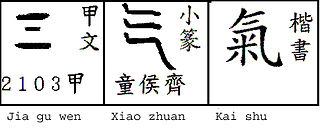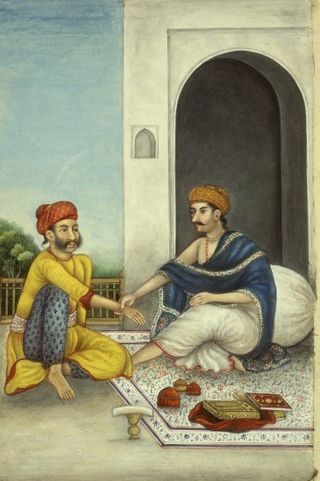
Traditional Chinese medicine (TCM) is an alternative medical practice drawn from traditional medicine in China. It has been described as pseudoscientific, with the majority of its treatments having no known mechanism of action.

Wuxing, usually translated as Five Phases or Five Agents, is a fivefold conceptual scheme used in many traditional Chinese fields of study to explain a wide array of phenomena, including cosmic cycles, the interactions between internal organs, the succession of political regimes, and the properties of herbal medicines.

In the Sinosphere, qi is traditionally believed to be a vital force part of all living entities. Literally meaning 'vapor', 'air', or 'breath', the word qi is polysemous, often translated as 'vital energy', 'vital force', 'material energy', or simply 'energy'. Qi is also a concept in traditional Chinese medicine and in Chinese martial arts. The attempt to cultivate and balance qi is called qigong.
The zangfu organs are functional entities stipulated by traditional Chinese medicine (TCM). These classifications are not based in physiology or science. They constitute the technological centrepiece of TCM's general concept of how the human body works. The term zang refers to the organs considered to be "solid" yin in nature – Heart, Liver, Spleen, Lung, Kidney – while fu refers to the "hollow" yang organs – Small Intestine, Large Intestine, Gall Bladder, Urinary Bladder, Stomach and San Jiao.
The model of the body in traditional Chinese medicine (TCM) has the following elements:
Jing is the Chinese word for "essence", specifically Kidney essence. Along with qi and shen, it is considered one of the Three Treasures of traditional Chinese medicine.
The Liver is one of the zàng organs stipulated by traditional Chinese medicine (TCM). It is a functionally defined entity and not equivalent to the anatomical organ of the same name.
The Heart is one of the zàng organs stipulated by Traditional Chinese Medicine (TCM). It is a functionally defined entity and not equivalent to the anatomical organ of the same name.
The Spleen is one of the zàng organs stipulated by traditional Chinese medicine (TCM). It is a functionally defined entity and not equivalent to the anatomical organ of the same name.
According to traditional Chinese medicine, the kidney refers to either of the two viscera located on the small of the back, one either side of the spine. As distinct from the Western medical definition of kidneys, the TCM concept is more a way of describing a set of interrelated parts than an anatomical organ. In TCM, the kidneys are associated with "the gate of Vitality" or "Ming Men". A famous Chinese doctor named Zhang Jie Bin wrote "there are two kidneys,, with the Gate of Vitality between them. The kidney is the organ of water and fire, the abode of yin and yang, the sea of essence, and it determines life and death."
The lungs is one of the zang organs described in traditional Chinese medicine. It is a functionally-defined entity and not equivalent to the anatomical organ of the same name.
The large intestine is one of the fu organs stipulated by traditional Chinese medicine (TCM). As distinct from the Western medical concept of large intestine, this concept from TCM is more a way of describing a set of interrelated parts than an anatomical organ. It is a functionally defined entity and not equivalent to the anatomical organ of the same name.
As distinct from the Western medical concept of the pericardium, this concept from traditional Chinese medicine describes a set of interrelated parts rather than an anatomical organ.

The meridian system is a traditional Chinese medicine (TCM) concept that alleges meridians are paths through which the life-energy known as "qi" (ch'i) flows.

In Chinese martial arts, there are fighting styles that are modeled after animals.

Pulse diagnosis is a diagnostic technique used in Ayurveda, traditional Chinese medicine, traditional Mongolian medicine, Siddha medicine, traditional Tibetan medicine, and Unani. Although it once showed many positive results, it no longer has scientific legitimacy, but research continues and is ill-defined in some derived text, and is subjective.
In the Japanese medical tradition and in Japanese martial arts traditions, the word Hara is used as a technical term for a specific area (physical/anatomical) or energy field (physiological/energetic) of the body. An alternative Japanese reading of the character is Fuku, the Chinese reading is Fu.
Fu's Subcutaneous Needle (FSN), invented by Dr. Zhonghua Fu in 1996, is a method for the treatment of myofascial pain and trigger points related to Traditional Chinese Medicine (TCM) and invented by Dr. D. Simons and Dr. Janet G. Travell.

Tongue diagnosis in Chinese Medicine is a method of diagnosing disease and disease patterns by visual inspection of the tongue and its various features. It is one of the major diagnostic methods in Chinese Medicine since the time of the Yellow Emperor's Inner Classic. It is considered a part of the “Inspection” method within the four methods of diagnosis. Practitioners claim that the tongue provides important clues reflecting the conditions of the internal organs. Like other diagnostic methods in Traditional Chinese Medicine, tongue diagnosis is based on the “outer reflects the inner” principle, which is that external structures often reflect the conditions of the internal structures and can give us important indications of internal disharmony.







